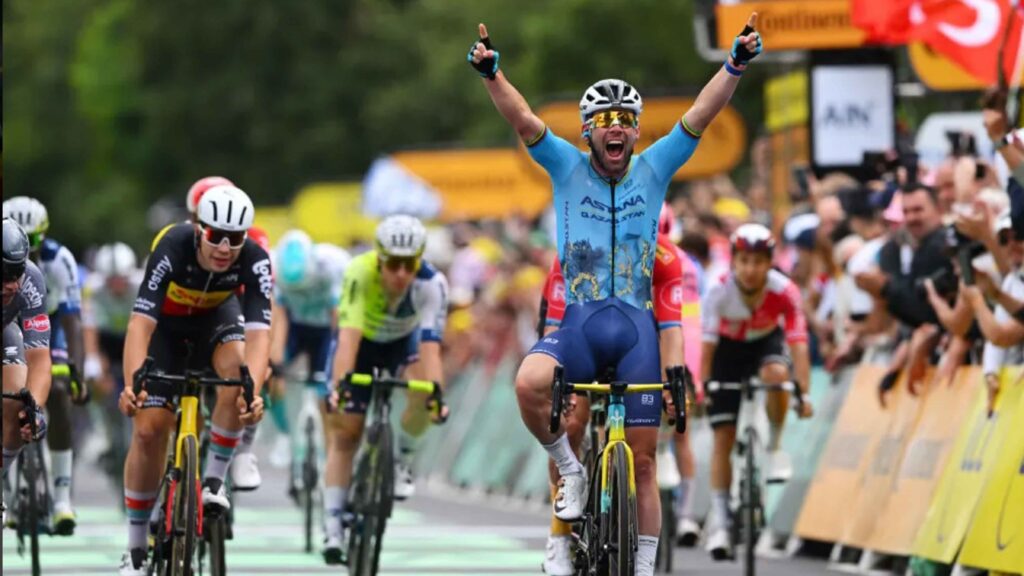Picture this. It’s June 2009 and I’m walking down the Seine in Paris enjoying the sultry summer weather.
“What are we doing tomorrow?”, I ask.
“It’s the final stage of the Tour”, he replies.
My romantic weekend has just taken an unexpected turn.
That Sunday, instead of climbing the Eiffel Tower, indulging my taste for French patisserie, or soaking up the ambience of Montmartre I found myself standing for 8 hours on the side of the Champs-Élysées holding all the kit (a lot of kit!) in 35+ degree heat waiting for a bunch of blokes in lycra to go flying past on bikes.
A clueless spectator back then, I witnessed records being broken, famous names performing incredible feats and romance of a different kind. The romance of Le Tour. By the end of the day I had fallen in love with the dynamics of the peloton. The peloton is a wonder of strategy, chance, individual brilliance and bravery, sacrifice and camaraderie.*
Attempting the impossible
That day I saw Mark Cavendish claim his 10th Tour de France Stage win on the Champs-Elysée. This year, Cav is attempting to do the seemingly impossible – win a record breaking 35th stage of the Tour at the ripe old age of 39, after a number of years of unfortunate crashes and general bad luck.
So it was I found myself parked in front of the TV watching as this year’s contenders lined up for the start, my eyes searching for Cav in the mix. Had he arrived unscathed? He had.
As the breakaway got established and the riders made their way up the first of 6 climbs, the cameras zoomed in on Cav. He was being dropped on a climb that would ordinarily not have bothered the specialist sprinter. And he did not look good. In fact, he looked very, very bad indeed. And we were only at the start of the first stage of a three week race. My heart plummeted. Was the dream of 35 over before it had begun?
For the rest of the 205km stage with its 3600m of climbing Cav’s team mates Michael Mørkøv, Cees Bol, Yevgeniy Fedorov and Davide Ballerinix were at their team leader’s side. Ice to cool him, water and food to sustain him, pace setting to guide him, and perhaps most important, words to encourage him. While at the front of the race an exciting battle was unfolding that would see Frenchman Romain Bardet claim his first ever yellow jersey in his career final Tour, the back of the race was just as gripping. Being the Lanterne Rouge is one thing. Missing the time cut is something else altogether.
Sticking to the plan
With things looking this grim, would the Astana team stick with their Tour goal? They could have hedged their bets and sent riders up the road to mitigate things in the event Cav was cut from the race. They could have tried for the break away, targetting a stage win for a different rider. They didn’t. They stuck with their plan to try and accomplish something that had so far proved impossible – to secure Cav’s 35th Tour de France stage win.
Roll the clock forward a few days to Stage 5. The legend that is Mark Cavendish earns Tour de France immortality outsprinting the current best in the world to take his 35th stage, and finally break Eddy Merckx’s long-standing record. This was a special moment and I am glad I witnessed it.
If you’re trying to achieve something that has, so far at least, been impossible there are a few things to learn from the peloton:
- Spilt goals don’t work for big ambitions – we’ve seen Tour teams with multiple goals fall apart and fail to achieve them time and again. When there is one overall aim, that all others are subordinate to, the clarity this provides for decision-making is gold. For the Astana team on 2 July 2024 the short-term goal was to get Cav to the end of the stage in service of the long term goal. Not introduce a new short-term goal at the expense of the long term.
- Shared ambition is key – personal ambitions are put aside in service of an overall ambition that is shared at a deep level. The win for any individual is a win for all. Passive nodding head superficial agreement won’t cut it. It takes personal sacrifice to do the big stuff.
- Deep connection – really know who is on the team with you. The heat got to Cav on Stage 1. His team, from top to bottom knew, how to respond and support him through that. Cav had to turn the pedals, but his team-mates knew how best to help him so that he could get through.
- You can’t become a team on Zwift – in person time together, doing hard stuff, and fun stuff, is vital. That’s the way to truly get to know each other. You can’t become a team a deeply connected team Zoom either.
- Belief -in the depths of discomfort for Cav and probably frustration and worry for the rest of the team, they continued to believe in their dream and their rider. And Cav continued to believe in himself. Stages 1 and 5 in my book demonstrated the power of that belief.
And just quietly, I wouldn’t put it past Cav to take another stage before this Tour is out.
*I also fell for the amateur cyclist who is now my husband.
Photo: Tour De France Mark Cavendish 2024
©Ann Braithwaite 2024

